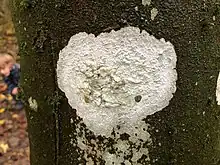| Phlyctis argena | |
|---|---|
 | |
| on a tree in Denmark | |
| Scientific classification | |
| Domain: | Eukaryota |
| Kingdom: | Fungi |
| Division: | Ascomycota |
| Class: | Lecanoromycetes |
| Order: | Gyalectales |
| Family: | Phlyctidaceae |
| Genus: | Phlyctis |
| Species: | P. argena |
| Binomial name | |
| Phlyctis argena | |
| Synonyms | |
| |
Phlyctis argena is a species of crustose lichen.[1]
Description
Phlyctis argena has a thin crustose thallus that is white, greyish or green-grey in colour. The identification can be confirmed with the spot test application a drop of potassium hydroxide (K-test) to the thallus, which will turn yellow and then red.
Range
Widespread, including Africa, Asia, Europa and North America.
Habitat
Phlyctis argena usually grows as a generalist epiphyte on the bark of deciduous trees, especially Salix cinerea and Fraxinus excelsior. It also occasionally grows on stone, such as gravestones.
Ecology
The lichen is a generalist epiphyte of deciduous trees and is acidophilic. Its abundance appears to have increased generally since the 1970s, possibly in responses to changes in pollution levels[2]
Etymology
The etymology of the genus name, Phlyctis, comes from the obsolete medical term phlyctidium, meaning a large blister. The species epithet, argena, is derived from the latin "argentum", meaning silver.
Taxonomy
The following varieties of Phlyctis argena have been described:
References
- 1 2 3 4 5 "Whitewash Lichen (Phlyctis argena)". iNaturalist. Retrieved 2022-10-20.
- ↑ Liška, Jiří; Herben, Tomáš (2008). "Long-term changes of epiphytic lichen species composition over landscape gradients: an 18 year time series". The Lichenologist. 40 (5): 437-448. doi:10.1017/S0024282908006610. S2CID 85771070.